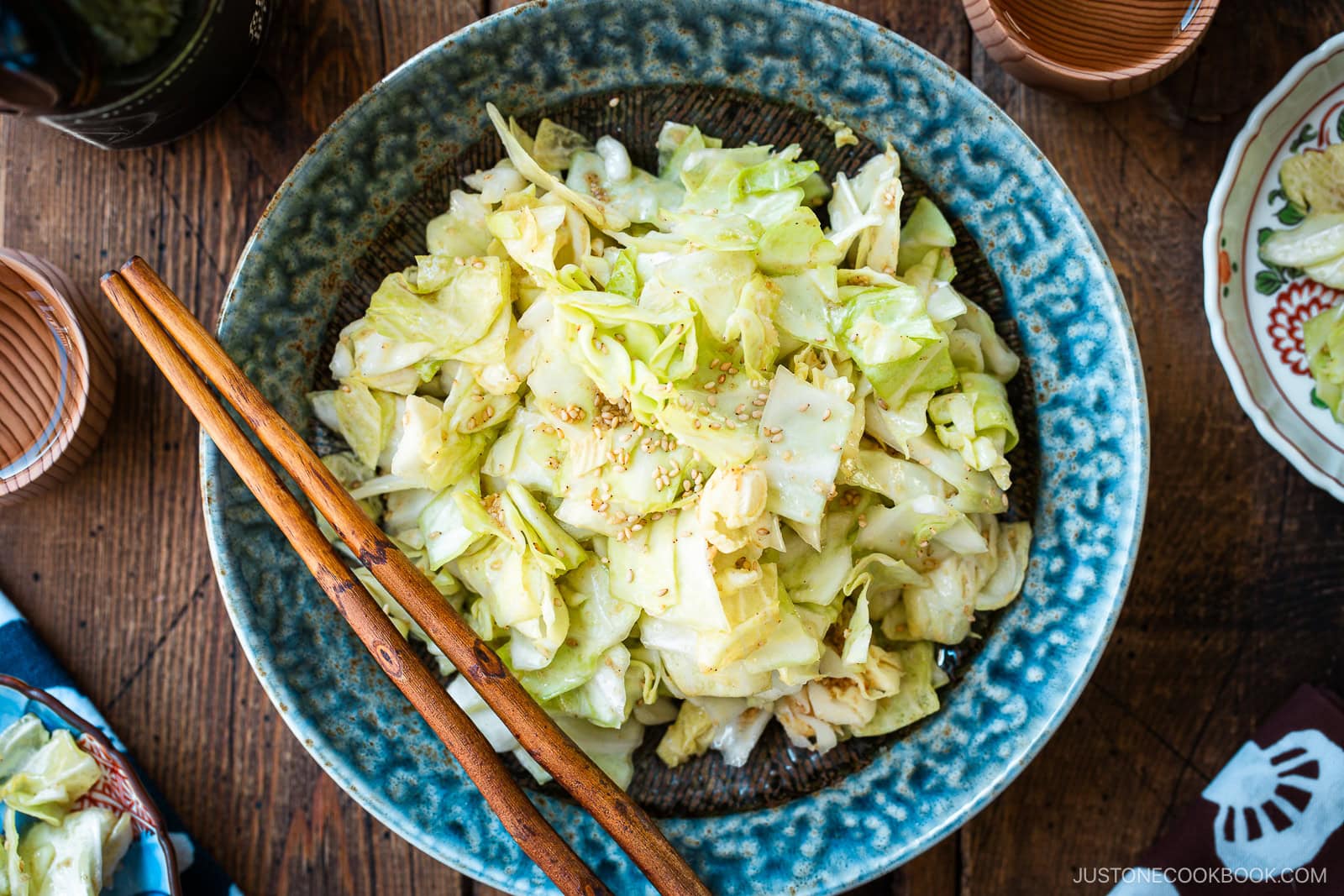Yamitsuki Cabbage is a delightful izakaya side dish that gained popularity through the renowned Japanese BBQ chain Gyukaku. This crisp cabbage, tossed in sesame oil, garlic, salt, sesame seeds, and umami seasoning, is incredibly simple yet utterly addictive. Once you try it, you’ll find yourself going back for seconds!
The humble cabbage undergoes a remarkable transformation in this addictive Yamitsuki Cabbage recipe. With its nutty and savory flavors combined with a delightful crunch, this no-cook side dish is a favorite in both Japanese pubs and homes. Achieving the perfect balance of fresh cabbage and umami seasoning is crucial, and I will guide you through it.
If you enjoy Japanese cabbage side dishes, be sure to check out my recipes for Japanese Pickled Cabbage, Asian Coleslaw with Sesame Dressing, and Stir-Fried Vegetables (Yasai Itame) next!
What is Yamitsuki Cabbage?
The Japanese BBQ chain Gyukaku (牛角) has been serving its signature yamitsuki cabbage for over two decades. In 2009, they began selling bottled sauce, allowing home cooks to recreate this delicious dish. Japanese home cooks often make their own variations of this shio kyabetsu dish using the same essential seasonings—salt, sesame oil, garlic, and white sesame seeds. The term yamitsuki translates to “addictive” in Japanese, and this crunchy, savory dish certainly lives up to its name.
Why I Love This Recipe
- Ready in just 5 minutes: Simply cut the cabbage and toss it with the seasonings. It’s perfect for those last-minute side dish needs during weeknight meals.
- Crispy, salty, and addictive: The irresistible combination of sesame oil, garlic, salt, and umami seasoning with fresh cabbage will have you coming back for more.
- Short ingredient list: The magic of this recipe lies in its simplicity, using just a handful of common ingredients.
- Affordable and healthy: Green cabbage is not only budget-friendly but also beneficial for gut health, packed with Vitamin C, dietary fiber, and calcium.
Ingredients for Yamitsuki Cabbage
- Green cabbage
- Kosher salt
- Umami-boosting seasoning: See below!
- Toasted white sesame seeds
- Toasted sesame oil
- Garlic cloves
What Are Umami-boosting Seasonings?
I used kobucha (kombu kelp tea powder) today, but common options include chicken bouillon or vegetable bouillon (I recommend Better Than Bouillon brand), shio kombu, shio koji, dashi powder or hondashi, and ground katsuobushi (bonito flakes).
* Available at Japanese grocery stores
Find the printable recipe with measurements below.
How to Make Yamitsuki Cabbage
Step 1 – Grind the sesame seeds. I prefer using a mortar and pestle, leaving some seeds unground for added texture. Next, crush the garlic.
Step 2 – Measure the cabbage. Firmly pack bite-sized pieces of torn or chopped cabbage into a measuring cup; 1 packed cup weighs 80 g. A large prep tray from JOC Goods fits 4 cups (320 g) of cabbage perfectly. Alternatively, you can use a plastic bag or large bowl.
Step 3 – Add the dry seasonings, then cover and shake. Sprinkle the salt and kobucha powder first to ensure even coating on each piece of cabbage before adding the wet seasonings.
Step 4 – Add the wet seasonings and toss to coat. Add the sesame oil, crushed garlic, and ground sesame seeds. Cover the tray again and shake to ensure the cabbage is thoroughly coated.
Step 5 – Serve immediately. Garnish with sesame seeds and enjoy.
Nami’s Recipe Tips
- Measure the cabbage: To maintain the seasonings-to-cabbage ratio, please use a measuring cup or kitchen scale. Using too much cabbage can lead to a bland taste.
- Dry the cabbage well: After washing, drain thoroughly. A salad spinner works well for this. Excess water will dilute the seasoning.
- Distribute the seasonings evenly: I recommend mixing the dry seasonings first to ensure each piece is coated before adding the wet ingredients.
- Stir the crushed garlic into the sesame oil: This prevents clumping in the dish.
- Use a prep tray with a lid: I prefer a large prep tray for mixing and storing leftovers. It’s a great gift for anyone who loves to cook!
Variations and Customizations
Also known as shio kyabetsu (“salt cabbage”), this addictive dish is easily customizable. Here are some of my favorite variations:
- Use another vegetable: In Japan, we often make this dish with whatever extra veggies we have. Consider using chopped napa cabbage, sliced daikon, carrots, zucchini, or blanched bean sprouts.
- Add chili pepper: For a bit of heat, incorporate a chili condiment. My favorites include yuzu kosho (citrus chili paste), shichimi togarashi (Japanese seven spice), and Crunchy Garlic Chili Oil (taberu rayu). Adjust the salt or sesame oil accordingly if using these.
- Use minced shallots: If you prefer a milder flavor, substitute raw garlic with shallots.
- Enhance flavors with Japanese touches: Try adding a sprinkle of furikake, a splash of shoyu (soy sauce), or a dash of black pepper.
What to Serve with Yamitsuki Cabbage
This 5-minute Yamitsuki Cabbage recipe serves as an irresistible appetizer, beer snack, or simple side dish. Here are some of my favorite pairings:
- With grilled meat: Serve it alongside Yakiniku (Japanese BBQ beef).
- With potstickers: Enjoy it as a substantial side dish to Gyoza (Japanese Pan-Fried Dumplings).
- With rice: It pairs wonderfully with Japanese-style Steak Garlic Rice.
- With soup: It complements hearty Tonjiru (Pork and Vegetable Miso Soup) beautifully.
- With a cold beverage: Just like in Japanese bars, it’s a perfect snack to enjoy with a beer or a non-alcoholic drink.
Storage Tips
To store: Keep in an airtight container in the fridge for up to 2–3 days.
Frequently Asked Questions
While I use a garlic press in the instructions to crush fresh garlic cloves, you may prefer a finer texture. You can grate it with a microplane grater or create a flavorful paste using the side of your knife and a pinch of salt.





